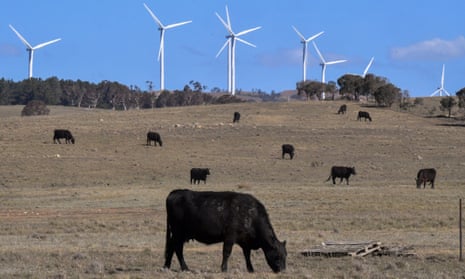Victoria’s ambitious emissions targets could be imperilled if the state government’s plan to slug renewable energy providers millions more in taxes each year goes ahead, the sector has warned.
Renewable energy providers could pay up to 20 times more tax if a bill being debated in Victorian parliament passes, according to industry experts.
The government’s state taxation acts and other acts amendment bill – expected to go to a vote in the upper house next week – seeks to expand the definition of “fixture” to capture any item “fixed to land”, by either a landowner or tenant.
This will include renewable energy infrastructure such as batteries, solar panels and wind turbines. Under the proposed legalisation, those assets can be deemed to significantly increase the value of the land, resulting in higher council rates, fire services levies and other taxes such as capital gains or windfall tax.
A state government spokesperson confirmed the intention of the amendment to the Valuation of Land Act 1960 was to reverse a 2021 supreme court decision that found windfarm assets on leased land did not constitute land to be valued.
“The amendment reinforces the original intention of the law,” the spokesperson said.
‘Serious disincentive to renewable energy’
Nicholas Aberle, the directory of energy generation policy and storage policy at the Clean Energy Council, said the move was “a serious disincentive to renewable energy investment in Victoria”.
“If passed, these changes would represent a real threat to Victoria’s renewable energy, renewable storage and emission reduction targets,” Aberle said.
“The government recently contracted almost 900MW of wind and solar farms through its VRET 2 auction round and are now turning around and increasing their taxes. These projects have no ability to increase their revenue to cover these costs.”
Aberle said, if passed, Victoria would become the only state to include the value of renewable energy infrastructure in the calculation for the fire services levy.
The Clean Energy Investment Group’s policy director, Marilyne Crestias, said under the proposed changes, the fire services levy for the 1.3GW Golden Plains windfarm – once complete – could soar beyond $2m a year, or $10,000 a turbine.
“This change risks making Victoria a less attractive place for renewables investment compared to other states or even overseas,” Crestias said. “We don’t want to deter international capital from being invested in the state.”
For large battery owners – who are not included in a scheme that allows councils and electricity generators to negotiate payments in lieu of rates – the increase could similarly cost millions.
Guardian Australia understand the 300MW Victorian Big Battery in Geelong, operated by the energy provider Neoen, could be slugged with $1.9m in rates in a single year if the scheme was not expanded to battery providers.
Renewable energy crucial for Victoria’s climate targets
The Victorian government has some of the nation’s most ambitious climate targets and has revived the State Electricity Commission to build and operate new renewable energy projects.
The government has committed to cutting emissions by 75% to 80% by 2035 and brought forward its zero emissions target to 2045.
It has also set a target for 95% of all electricity to come from renewable energy by 2035 and to have 6.3GW of storage by 2035 – enough to power about half of Victoria’s current homes at their peak energy usage.
But Crestias warned the state would need to ramp up its efforts in order to meet these targets. “The will is there from clean energy investors but we need clearer policy from the government,” she said. “Clarity will help drive investment and ensure we limit global warming to 1.5C.”
The government spokesperson said Victoria “leads the nation in supporting the growth of renewable energy to secure a green energy future”.
The government requires the support of all four Greens MPs and two other crossbenchers to pass the bill – which also would expand taxes on vacant homes and undeveloped land.
This month the government was forced to push back a vote on the legislation after it the Greens ruled out supporting it in its current form.
Guardian Australia understands negotiations have resumed between key crossbenchers and the treasurer, Tim Pallas, who has returned from a trade and investment mission to China, Europe and the US.
